ReentrantLock源码
Posted cao_null
tags:
篇首语:本文由小常识网(cha138.com)小编为大家整理,主要介绍了ReentrantLock源码相关的知识,希望对你有一定的参考价值。
结构
类图
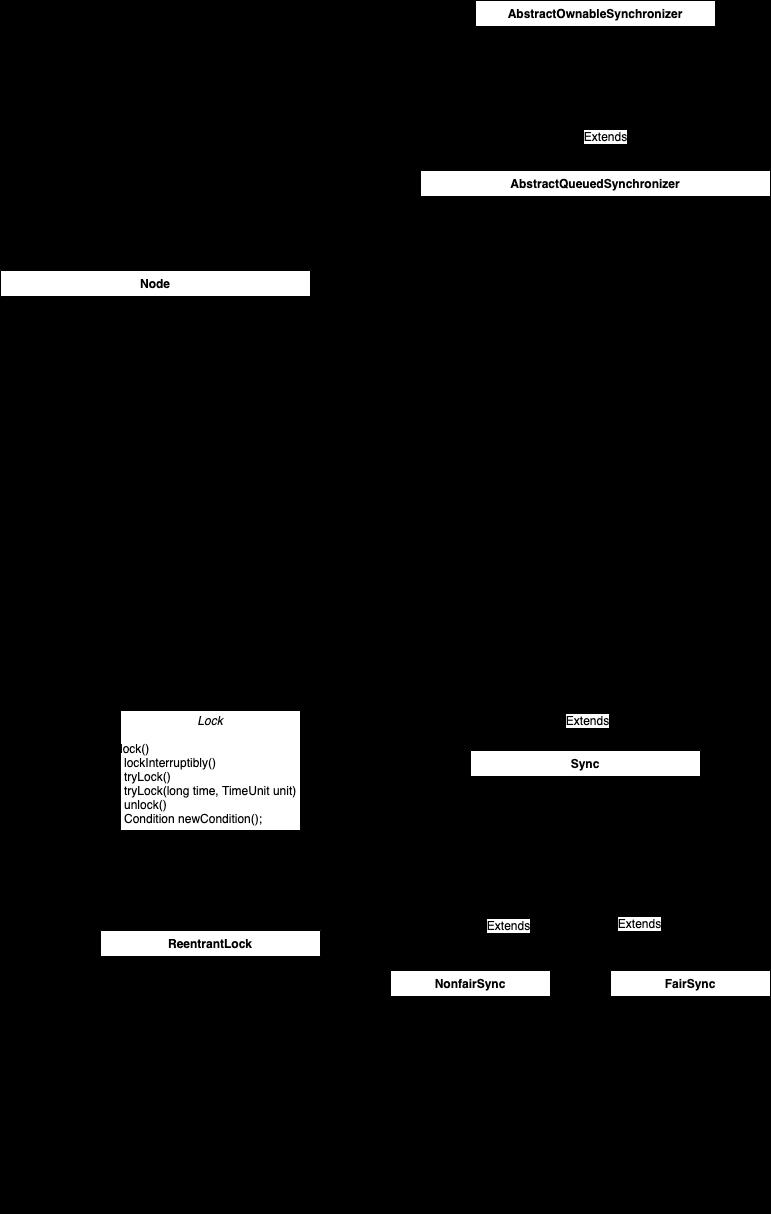
构造方法
//java.util.concurrent.locks.ReentrantLock
//默认非公平锁
public ReentrantLock() {
sync = new NonfairSync();
}
public ReentrantLock(boolean fair) {
sync = fair ? new FairSync() : new NonfairSync();
}
//执行lock实际上是执行sync的lock方法
public void lock() {
sync.lock();
}
加锁
先上流程图

我们先看非公平锁的加锁过程
//java.util.concurrent.locks.ReentrantLock
NonfairSync内部类
final void lock() {
if (compareAndSetState(0, 1))
setExclusiveOwnerThread(Thread.currentThread());
else
acquire(1);
}compareAndSetState方法写在AQS里面
//java.util.concurrent.locks.AbstractQueuedSynchronizer
public abstract class AbstractQueuedSynchronizer
extends AbstractOwnableSynchronizer
implements java.io.Serializable {
/**
* 同步状态,初始化后为0
*/
private volatile int state;
private transient volatile Node head;
private transient volatile Node tail;
//unsafe在这获取
private static final Unsafe unsafe = Unsafe.getUnsafe();
private static final long stateOffset;
private static final long headOffset;
private static final long tailOffset;
private static final long waitStatusOffset;
private static final long nextOffset;
//静态代码块获取偏移量
static {
try {
stateOffset = unsafe.objectFieldOffset
(AbstractQueuedSynchronizer.class.getDeclaredField("state"));
headOffset = unsafe.objectFieldOffset
(AbstractQueuedSynchronizer.class.getDeclaredField("head"));
tailOffset = unsafe.objectFieldOffset
(AbstractQueuedSynchronizer.class.getDeclaredField("tail"));
waitStatusOffset = unsafe.objectFieldOffset
(Node.class.getDeclaredField("waitStatus"));
nextOffset = unsafe.objectFieldOffset
(Node.class.getDeclaredField("next"));
} catch (Exception ex) { throw new Error(ex); }
}
//第一次是0,所以成功设置为1,代表已经获取到锁了
protected final boolean compareAndSetState(int expect, int update) {
// See below for intrinsics setup to support this
return unsafe.compareAndSwapInt(this, stateOffset, expect, update);
}第一次返回true,继续执行setExclusiveOwnerThread
//java.util.concurrent.locks.AbstractOwnableSynchronizer
private transient Thread exclusiveOwnerThread;
//设置独占线程
protected final void setExclusiveOwnerThread(Thread thread) {
exclusiveOwnerThread = thread;
}第一次lock代码很简单,再看第二次lock,此时compareAndSetState返回false,所以走acquire(1);
//java.util.concurrent.locks.AbstractQueuedSynchronizer
public final void acquire(int arg) {
//子类实现的,返回false则继续执行
if (!tryAcquire(arg) &&
acquireQueued(addWaiter(Node.EXCLUSIVE), arg))
selfInterrupt();
}调用tryAcquire
//java.util.concurrent.locks.ReentrantLock
//NonfairSync内部类
protected final boolean tryAcquire(int acquires) {
return nonfairTryAcquire(acquires);
}
final boolean nonfairTryAcquire(int acquires) {
final Thread current = Thread.currentThread();
int c = getState();
//锁已经被释放,重设锁
if (c == 0) {
if (compareAndSetState(0, acquires)) {
setExclusiveOwnerThread(current);
return true;
}
}
//获取锁的线程和当前线程是同一个,这是重入锁关键
else if (current == getExclusiveOwnerThread()) {
//锁status计数器加一
int nextc = c + acquires;
if (nextc < 0) // overflow
throw new Error("Maximum lock count exceeded");
setState(nextc);
return true;
}
//走到这说明需要等待锁,返回false继续往下走
return false;
}继续看acquireQueued
//java.util.concurrent.locks.AbstractQueuedSynchronizer
//Node是一个内部类
static final class Node {
static final Node EXCLUSIVE = null;
}
Node(Thread thread, Node mode) { // Used by addWaiter
this.nextWaiter = mode;
this.thread = thread;
}
private Node addWaiter(Node mode) {
Node node = new Node(Thread.currentThread(), mode);
// Try the fast path of enq; backup to full enq on failure
Node pred = tail;
if (pred != null) {
node.prev = pred;
if (compareAndSetTail(pred, node)) {
pred.next = node;
return node;
}
}
//插入队列
enq(node);
return node;
}
private final boolean compareAndSetHead(Node update) {
return unsafe.compareAndSwapObject(this, headOffset, null, update);
}
/**
* Inserts node into queue, initializing if necessary. See picture above.
* @param node the node to insert
* @return node's predecessor
*/
private Node enq(final Node node) {
for (;;) {
Node t = tail;
if (t == null) { // 第一次tail是null,CAS设置为头
if (compareAndSetHead(new Node()))
tail = head;//tail和head都设置为上面new Node,之后重新走第二次循环
} else {
//然后把当前node插入队尾
node.prev = t;
if (compareAndSetTail(t, node)) {
t.next = node;
return t;
}
}
}
}接下来看acquireQueued
//java.util.concurrent.locks.AbstractQueuedSynchronizer
final boolean acquireQueued(final Node node, int arg) {
boolean failed = true;
try {
boolean interrupted = false;
for (;;) {
final Node p = node.predecessor();
//第一次执行到这,这里的p就是之前设置的head,所以条件p == head成立
//再次执行tryAcquire假设还锁没有释放,则返回false
if (p == head && tryAcquire(arg)) {
...
}
if (shouldParkAfterFailedAcquire(p, node) &&//第二次返回true,继续执行parkAndCheckInterrupt()方法
parkAndCheckInterrupt())
interrupted = true;
}
} finally {
if (failed)
cancelAcquire(node);
}
}
Node内部方法
final Node predecessor() throws NullPointerException {
Node p = prev;
if (p == null)
throw new NullPointerException();
else
return p;
}
private static boolean shouldParkAfterFailedAcquire(Node pred, Node node) {
int ws = pred.waitStatus;//第一次执行为Node默认waitStatus为0
if (ws == Node.SIGNAL)//第二次直接返回true
/*
* This node has already set status asking a release
* to signal it, so it can safely park.
*/
return true;
if (ws > 0) {
/*
* Predecessor was cancelled. Skip over predecessors and
* indicate retry.
*/
do {
node.prev = pred = pred.prev;
} while (pred.waitStatus > 0);
pred.next = node;
} else {
/*
* waitStatus must be 0 or PROPAGATE. Indicate that we
* need a signal, but don't park yet. Caller will need to
* retry to make sure it cannot acquire before parking.
*/
//CAS设pred为SIGNAL状态
compareAndSetWaitStatus(pred, ws, Node.SIGNAL);
}
return false;
}
//这部分代码比较简单,只是挂起线程
private final boolean parkAndCheckInterrupt() {
LockSupport.park(this);
return Thread.interrupted();
}
Node结构图
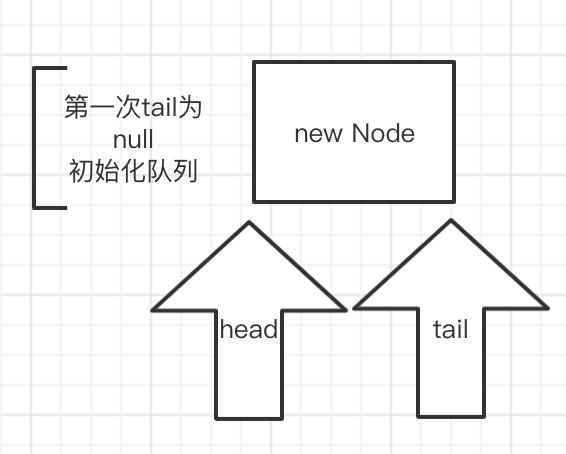
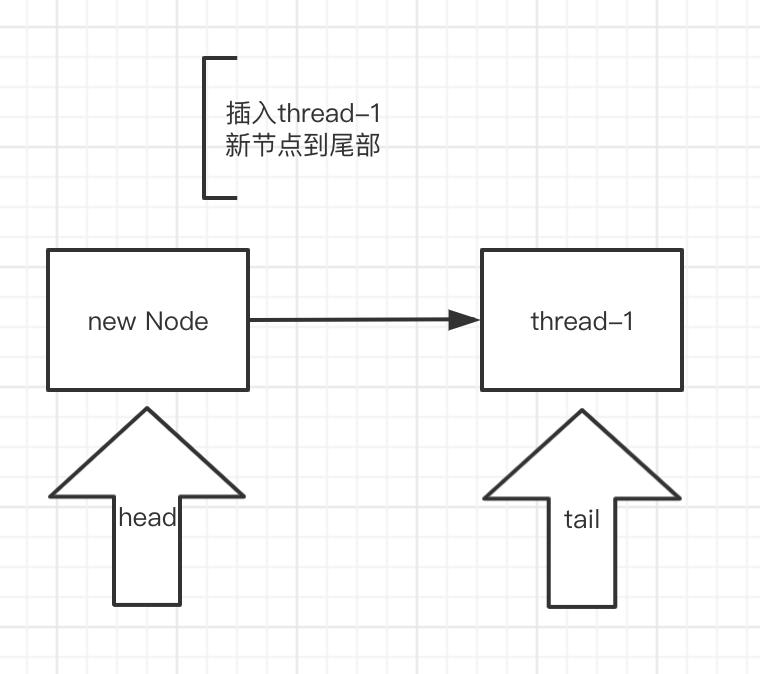
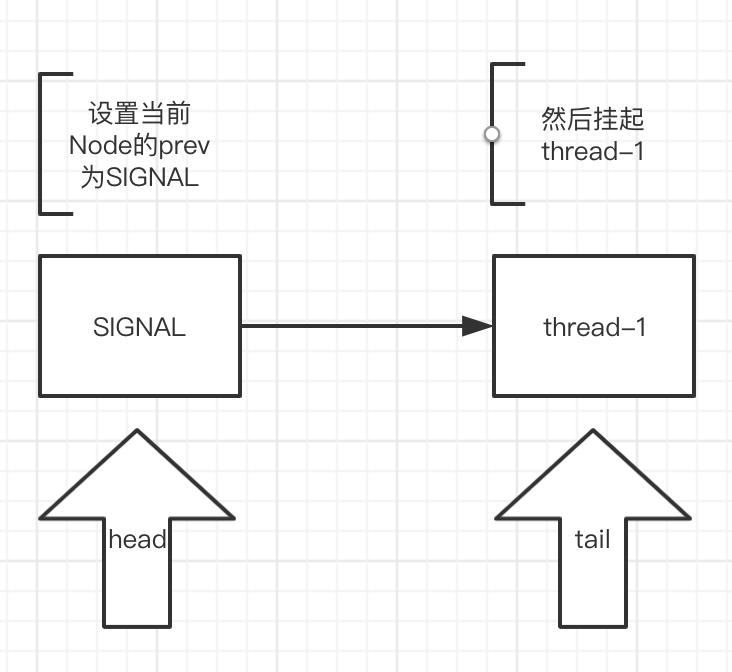
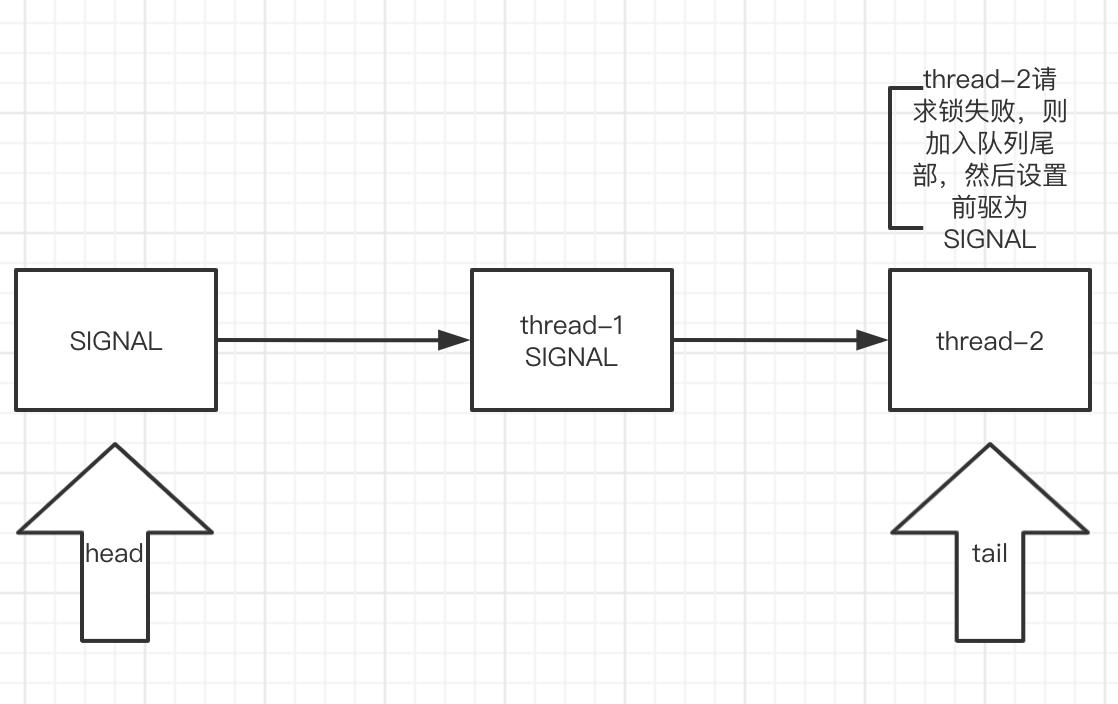
释放锁
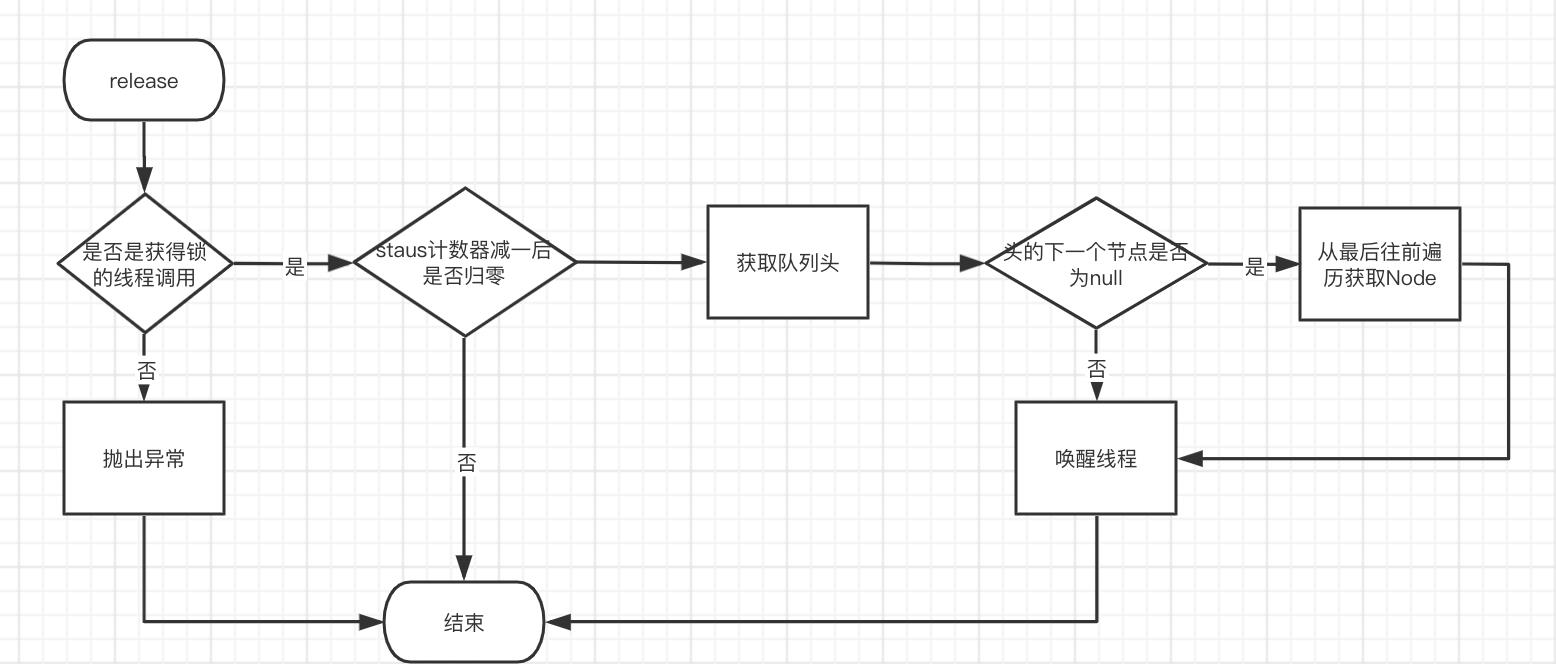
lock过程基本分析完成,接下来看unlock
//java.util.concurrent.locks.ReentrantLock
public void unlock() {
sync.release(1);
}
//java.util.concurrent.locks.AbstractQueuedSynchronizer
public final boolean release(int arg) {
if (tryRelease(arg)) {
Node h = head;
//如果之前等待队列生成了head,则会执行unparkSuccessor
if (h != null && h.waitStatus != 0)
unparkSuccessor(h);
return true;
}
return false;
}
//java.util.concurrent.locks.ReentrantLock
Sync 内部类
protected final boolean tryRelease(int releases) {
int c = getState() - releases;
//没有拥有锁的线程调用会直接崩溃
if (Thread.currentThread() != getExclusiveOwnerThread())
throw new IllegalMonitorStateException();
boolean free = false;
//c==0说明线程已经释放了锁,可以被其他线程获取了
if (c == 0) {
free = true;
setExclusiveOwnerThread(null);
}
setState(c);
return free;
}
//java.util.concurrent.locks.AbstractQueuedSynchronizer
private void unparkSuccessor(Node node) {
/*
* If status is negative (i.e., possibly needing signal) try
* to clear in anticipation of signalling. It is OK if this
* fails or if status is changed by waiting thread.
*/
int ws = node.waitStatus;
if (ws < 0)
compareAndSetWaitStatus(node, ws, 0);
/*
* Thread to unpark is held in successor, which is normally
* just the next node. But if cancelled or apparently null,
* traverse backwards from tail to find the actual
* non-cancelled successor.
*/
//获取head的next,然后判空,此处先忽略为null或者waitStatus > 0情况
Node s = node.next;
if (s == null || s.waitStatus > 0) {
s = null;
for (Node t = tail; t != null && t != node; t = t.prev)
if (t.waitStatus <= 0)
s = t;
}
if (s != null)//重新唤醒线程
LockSupport.unpark(s.thread);
}在这唤醒后,会返回之前挂起的地方,我们回过头看之前的代码
//返回线程的中断状态
private final boolean parkAndCheckInterrupt() {
LockSupport.park(this);
return Thread.interrupted();
}
final boolean acquireQueued(final Node node, int arg) {
boolean failed = true;
try {
boolean interrupted = false;
for (;;) {
final Node p = node.predecessor();
//如果当前Node的上一节点是head,则重设head
if (p == head && tryAcquire(arg)) {
setHead(node);
p.next = null; // help GC
failed = false;
return interrupted;
}
//如果这里是true则设置interrupted状态,然后返回for循环
if (shouldParkAfterFailedAcquire(p, node) &&
parkAndCheckInterrupt())
interrupted = true;
}
} finally {
if (failed)
cancelAcquire(node);
}
}
//然后返回这
public final void acquire(int arg) {
//如果状态状态是true则执行selfInterrupt
if (!tryAcquire(arg) &&
acquireQueued(addWaiter(Node.EXCLUSIVE), arg))
selfInterrupt();
}
//尝试把自己中断
static void selfInterrupt() {
Thread.currentThread().interrupt();
}另一个之前没解决的问题是head的next节点什么情况waitStatus > 0,CANCELLED = 1,所以证明中间节点被cancel的时候则状态变了。一般来说failed只有发生异常等情况会为true,但是有一种情况例外,我们来看下。
private void doAcquireInterruptibly(int arg)
throws InterruptedException {
final Node node = addWaiter(Node.EXCLUSIVE);
boolean failed = true;
try {
for (;;) {
final Node p = node.predecessor();
if (p == head && tryAcquire(arg)) {
setHead(node);
p.next = null; // help GC
failed = false;
return;
}
if (shouldParkAfterFailedAcquire(p, node) &&
//之前在这挂起。如果调用interrupt则parkAndCheckInterrupt方法中执行park后的代码
parkAndCheckInterrupt())
//在这直接抛异常,不再执行for,也就是failed依然是true,然后执行finally
throw new InterruptedException();
}
} finally {
if (failed)
cancelAcquire(node);
}
}看cancelAcquire方法
private void cancelAcquire(Node node) {
// Ignore if node doesn't exist
if (node == null)
return;
node.thread = null;
// Skip cancelled predecessors
Node pred = node.prev;
while (pred.waitStatus > 0)//往前遍历找到之前一个没被cancel的节点
node.prev = pred = pred.prev;
// predNext is the apparent node to unsplice. CASes below will
// fail if not, in which case, we lost race vs another cancel
// or signal, so no further action is necessary.
Node predNext = pred.next;
// Can use unconditional write instead of CAS here.
// After this atomic step, other Nodes can skip past us.
// Before, we are free of interference from other threads.
node.waitStatus = Node.CANCELLED;
// If we are the tail, remove ourselves.
//如果现在已经是队尾,则移除自己,成功则设置后继节点为null
if (node == tail && compareAndSetTail(node, pred)) {
compareAndSetNext(pred, predNext, null);
} else {
// If successor needs signal, try to set pred's next-link
// so it will get one. Otherwise wake it up to propagate.
//
int ws;
if (//此处判断较多拆开分析
//当前节点的前驱节点不是head
pred != head &&
//前驱节点的状态是SIGNAL
((ws = pred.waitStatus) == Node.SIGNAL ||
//否则尝试设置前驱的status为SIGNAL
(ws <= 0 && compareAndSetWaitStatus(pred, ws, Node.SIGNAL))) &&
//上面两个满足其中一个,判断前驱thread是否为null
pred.thread != null) {
//设置前驱节点的next节点为当前Node的next节点,等于删除了当前Node
Node next = node.next;
if (next != null && next.waitStatus <= 0)
compareAndSetNext(pred, predNext, next);
} else {
//假设前驱thread为null,也就是当前前驱为head,则唤醒当前Node的后继节点线程
unparkSuccessor(node);
}
node.next = node; // help GC
}
}回到之前的问题:
为什么在unparkSuccessor的时候,如果node.next==null或者waitStatus > 0寻找节点从后往前?代码如下:
Node s = node.next;
if (s == null || s.waitStatus > 0) {
s = null;
for (Node t = tail; t != null && t != node; t = t.prev)
if (t.waitStatus <= 0)
s = t;
}
//我们模拟多线程的一些特殊情况
private Node addWaiter(Node mode) {
Node node = new Node(Thread.currentThread(), mode);
// Try the fast path of enq; backup to full enq on failure
Node pred = tail;
if (pred != null) {
node.prev = pred;
if (compareAndSetTail(pred, node)) {
//假设执行到这里被挂起
//tail已经为最新的node,但是从前往后遍历找不到tail
pred.next = node;
return node;
}
}
//插入队列
enq(node);
return node;
}
公平锁
//java.util.concurrent.locks.ReentrantLock
//内部类
protected final boolean tryAcquire(int acquires) {
final Thread current = Thread.currentThread();
int c = getState();
if (c == 0) {
//线程没有等待的线程,抢锁成功才返回true
if (!hasQueuedPredecessors() &&
compareAndSetState(0, acquires)) {
setExclusiveOwnerThread(current);
return true;
}
}
else if (current == getExclusiveOwnerThread()) {
int nextc = c + acquires;
if (nextc < 0)
throw new Error("Maximum lock count exceeded");
setState(nextc);
return true;
}
return false;
}
//java.util.concurrent.locks.AbstractQueuedSynchronizer
//检查队列中是否已经有等待的线程了
public final boolean hasQueuedPredecessors() {
// The correctness of this depends on head being initialized
// before tail and on head.next being accurate if the current
// thread is first in queue.
Node t = tail; // Read fields in reverse initialization order
Node h = head;
Node s;
//head==tail队列是空
return h != t &&
//队列不为空head的next==null说明有线程正在入列
((s = h.next) == null
//head的next也有值,但是跟当前线程不是同一个,说明有线程已经在等待了
|| s.thread != Thread.currentThread());
}综上所示,非公平锁先抢锁,再入列,公平锁只有队列为空才抢锁。非公平锁更早入列的线程,有可能饿死。
以上是关于ReentrantLock源码的主要内容,如果未能解决你的问题,请参考以下文章